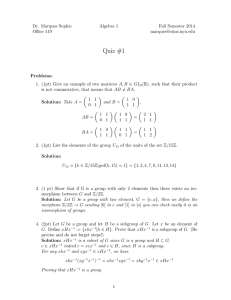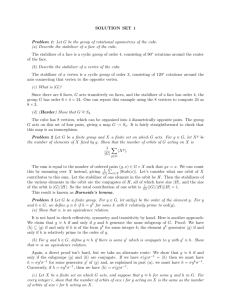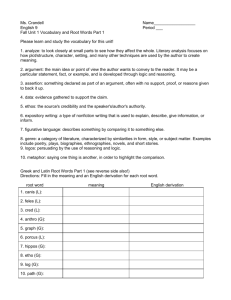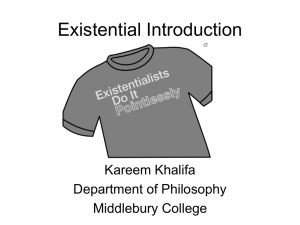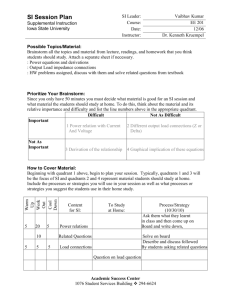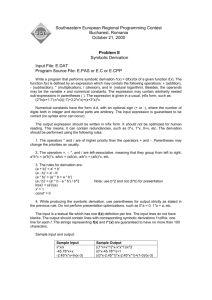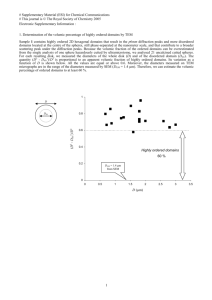INTRO LOGIC
advertisement
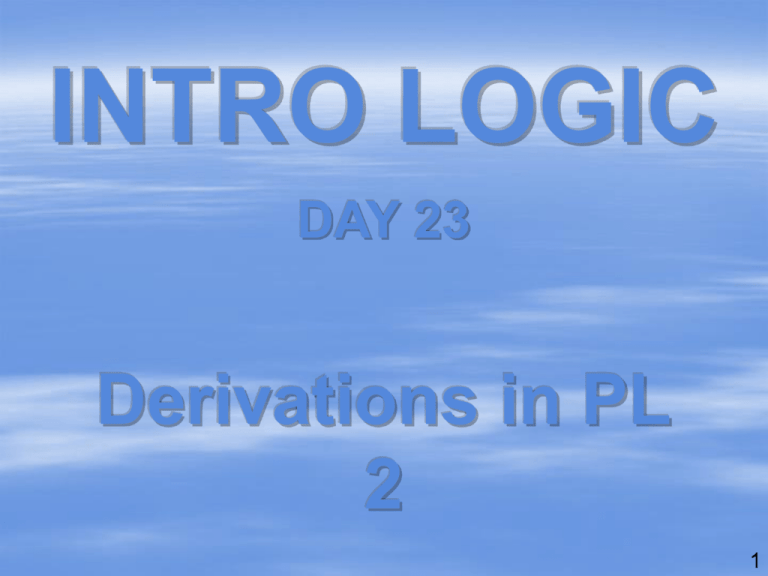
INTRO LOGIC DAY 23 Derivations in PL 2 1 Overview + Exam 1 Exam 2 Exam 3 Exam 4 6 derivations Exam 5 Exam 6 Sentential Logic Translations (+) Sentential Logic Derivations Predicate Logic Translations Predicate Logic Derivations @ 15 points + 10 free points very similar to Exam 3 very similar to Exam 4 + + 2 Rule Sheet Intro Logic provided on exams &I &O –––––– & –––––– & I O –––––– –––––– available on course web page (textbook) I –––––– –––––– O ––––––– ––––––– I see CD DN O O : CD ( ) –––––––––– & : : D Rep –– O DD –– (ID) : () D O ––––– –––– D ( ) –––––––––– ––––––– DN ––––– ( ) ––––––––– O ––––––– ––––––– ––––––– I keep this in front of you when doing homework SENTENTIAL LOGIC Rules of Derivation &O &D & & ( & ) : & –––––– –––––– ––––––––– : : ID : : : PREDICATE LOGIC In the following, is any variable; [] is any formula in which occurs free; [o] results by substituting o for every free occurrence of , where o is any old name. [n] results by substituting n for every free occurrence of , where n is any new name. A name counts as old if it occurs in a line that is neither boxed nor cancelled; otherwise it counts as new. I see UD O O UD [] : [] –––––– –––––– new : [n] [o] old I O [o] old –––––– [] [] –––––– [n] D O new [] –––––– [] don’t make up your own rules (ID) : [] [] : 4 Sentential Logic Rules DD ID CD D &D etc. &I &O vO O O etc. 5 Predicate Logic Rules Universal Derivation Universal-Out Tilde-Universal-Out UD O O day 2 day 1 day 3 Existential-In Existential-Out Tilde-Existential-Out I O O day 1 day 2 day 3 6 Rules Already Introduced – Day 1 O ––––– ––––– I is an OLD name (more about this later) 7 Rules to be Introduced Today Universal Derivation UD Existential-Out O 8 Example 1 every F is H ; everyone is F / everyone is H (1) x(Fx Hx) Pr (2) xFx Pr (3) : xHx ?? (3) : Ha & Hb & Hc & ……… &.&.&.D (a) (?) (b) (?) (c) (?) … : Ha ?? : Hb ?? : Hc ?? … what is ?? ultimately ?? involved ?? in ?? ?? ?? … showing a universal 9 Example 1a (1) x(Fx Hx) Pr (2) xFx Pr (3) : xHx (4) : Ha ?? DD (5) Fa Ha 1, O (6) Fa 2, O (7) Ha 5,6, O one down, a zillion to go! 10 Example 1b (1) x(Fx Hx) Pr (2) xFx Pr (3) : xHx (4) : Hb ?? DD (5) Fb Hb 1, O (6) Fb 2, O (7) Hb 5,6, O two down, a zillion to go! 11 Example 1c (1) x(Fx Hx) Pr (2) xFx Pr (3) : xHx (4) : Hc ?? DD (5) Fc Hc 1, O (6) Fc 2, O (7) Hc 5,6, O three down, a zillion to go! 12 But wait – the derivations all look alike! (4) (5) (6) (7) : Ha Fa Ha (4) (5) (6) (7) : Hb Fb Hb (4) (5) (6) (7) : Hc Fc Hc Fa Ha Fb Hb Fc Hc DD 1,O 2,O 5,6,O DD 1,O 2,O 5,6,O DD 1,O 2,O 5,6,O 13 The Universal-Derivation Strategy So, all we need to do is do one derivation with one name (say, ‘a’) and then argue that all the other derivations will look the same. To ensure this, we must ensure that the name is general, which we can do by making sure the name we select is NEW. a name counts as NEW precisely if it occurs nowhere in the derivation unboxed or uncancelled 14 The Universal-Derivation Rule (UD) : UD : ?? is any variable is any (official) formula replaces ° must be a NEW name, ° i.e., one that is occurs nowhere in the derivation unboxed or uncancelled ° ° 15 Comparison with Universal-Out O UD ––––– : OLD name NEW name a name counts as OLD precisely if it occurs somewhere in the derivation unboxed and uncancelled : a name counts as NEW precisely if it occurs nowhere in the derivation unboxed or uncancelled 16 Example 2 every F is H / if everyone is F, then everyone is H (1) x(Fx Hx) Pr (2) : xFx xHx CD (4) xFx : xHx As UD (5) : Ha DD (3) a new (6) Fa Ha 1, O a old (7) Fa 3, O a old (8) Ha 6,7, O 17 Example 3 every F is G ; every G is H / every F is H (1) (2) x(Fx Gx) x(Gx Hx) Pr Pr (3) : x(Fx Hx) : Fa Ha UD CD (4) (5) Fa As (6) : Ha DD a new (7) Fa Ga 1, O a old (8) Ga Ha 2, O a old (9) Ga 5,7, O (10) Ha 8,9, O 18 Example 4 everyone R’s everyone / everyone is R’ed by everyone (1) xyRxy Pr (2) : xyRyx UD a new (3) : yRya : Rba UD DD b new (4) (5) yRby 1, (6) Rba 5, O b old O a old 19 Existential-Out (O) any variable (z, y, x, w …) any formula ––––– replaces any NEW name (a, b, c, d, …) 20 Comparison with Universal-Out O –––––– –––––– OLD name NEW name a name counts as OLD precisely if it occurs somewhere unboxed and uncancelled O a name counts as NEW precisely if it occurs nowhere unboxed or uncancelled 21 Example 5 every F is un-H / no F is H (1) x(Fx Hx) Pr (2) : x(Fx & Hx) D (3) x(Fx & Hx) As (4) : DD (5) Fa & Ha 3, O new (6) Fa Ha 1, O (7) Fa (8) Ha 5, &O (9) Ha 6,7, O (10) 8,9, I old 22 Example 6 some F is not H / not every F is H (1) x(Fx & Hx) Pr (2) : x(Fx Hx) (3) x(Fx Hx) ID As (4) : DD (5) Fa & Ha 1, O new (6) Fa Ha 3, O old (7) Fa (8) Ha 5, &O (9) Ha 6,7, O (10) 8,9, I 23 Example 7 every F is G ; some F is H / some G is H (1) x(Fx Gx) Pr (2) x(Fx & Hx) (3) : x(Gx & Hx) Pr DD (4) Fa & Ha 2, O new (5) Fa Ga 1, O old (6) Fa (7) Ha 4, &O (8) Ga 5,6, O (9) Ga & Ha 7,8, &I (10) x(Gx & Hx) 9, I 24 Example 8 if anyone is F then everyone is H / if someone is F, then everyone is H (1) x(Fx xHx) Pr (2) : xFx xHx (3) xFx CD As (4) : xHx UD (5) : Ha DD new (6) Fb 3, O new (7) Fb xHx 1, O old (8) xHx 6,7, O (9) Ha 8, O old 25 Example 9 if someone is F, then everyone is H / if anyone is F then everyone is H (1) xFx xHx Pr (2) : x(Fx yHy) (3) : Fa yHy UD CD (4) Fa As (5) : yHy UD (6) : Hb DD new new (7) xFx 4, I (8) xHx 1,7, O (9) Hb 8, O old 26 Example 10 (a fragment) someone R’s someone ??missing premises?? / everyone R’s everyone (1) xyRxy Pr (2) ??? (3) : xyRxy Pr UD new new (4) : yRay UD (5) : Rab ?? (6) yRcy (7) Rcd 1, O new 6, O new (8) ?? ?? 27 THE END 28
